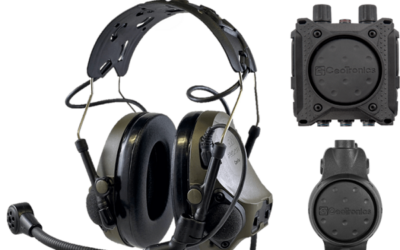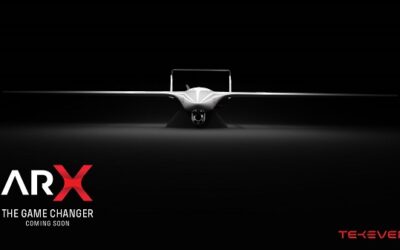Leonardo is bullish regarding the prospects for its Grifo family of X-band (8.5 gigahertz/GHz to 10.68GHz) fighter aircraft fire control radars. During a visit to the company’s facilities in Milan, northern Italy, officials told MONch that the firm is confident it will perform the first test flights of its new Grifo E-Scan AESA (Active Electronically Scanned Array) radar towards the end of 2019. The radar is currently under development with the configuration to be tested intended for Alenia/Leonardo M-346 lead-in fighter trainer/light fighter operators, and undisclosed users of other aircraft types (light fighter/attack aircraft) not revealed by the firm.
The Grifo E-Scan represents the latest evolution of the Grifo family which has been in production since the 1990s. The company continues to aim the radar at the retrofit, as well as the new-build, fighter/ground attack markets. The first contract for the Grifo-F was concluded in 1992 with the installation of the radar on-board the Republic of Singapore Air Force’s Northrop Grumman F-5E/F. The firm is continuing to equip F-5 operators and is currently completing a contract to provide the Grifo-F/TN to an F-5 operator in the Asia-Pacific, thought to be either Thailand or Taiwan. This version includes new Synthetic Aperture Radar (SAR) and Inverse SAR modes. A total of 16 Grifo-F/TNs are being delivered, plus spares, with deliveries ongoing. Other F-5 operators have retrofitted their aircraft with Grifo variants. These have included the Força Aérea Brasileira (Brazilian Air Force) which flies the Grifo-F/SR on-board its F-5EM.
Leonardo officials stated that, to date, they have manufactured 450 Grifo radars which have amassed a total of over 150,000 flying hours. Beyond the F-5, other users include the Pakistan Air Force (PAF) which flies the Grifo-M/L on its Dassault Mirage-III family combat aircraft. Elsewhere in the PAF, the service’s Chengdu F-7G fighters are equipped with the Grifo-7, which replaced the legacy Marconi/Ferranti Skyranger radars equipping these aircraft. The Aero L-159A of the Vzdušné Síly Armády České Republiky (Czech Republic Air Force) and similar aircraft operated by the Iraqi Air Force carry the Grifo-L, as do the L-159E aircraft flown by the private-sector air combat training company Draken International. Grifo radar installations have not been confined to fighters, with the Republic of Korea Air Force’s Sikorsky HH-60P Combat Search and Rescue helicopters outfitted with Grifo.
Grifo E-Scan
Leonardo is now modernising the radar. This is taking a twin approach of overhauling the mechanically-scanned array version of the Grifo, known as the Grifo M-Scan, and the realisation of a version of the radar equipped with an AESA array, known as the Grifo E-Scan. The company is currently working on a new eight-channel receiver for the Grifo E-Scan. The radar’s architecture includes a liquid-cooled antenna with 600 transmit/receive elements, the eight-channel receiver/exciter processor and the radar’s liquid- or air-cooled power supply. The design was unveiled at the Farnborough Air Show held in 2017 in southern England. The antenna is being developed by Leonardo’s site in Edinburgh, Scotland with the facility in Milan developing the radar’s back end. The antenna will use Gallium Nitride which can tolerate higher operating temperatures compared to the Gallium Arsenide used in the first generation of AESA radars, and hence affording improvements to the radar’s range and performance while reducing the maintenance, repair and overhaul burden. The company added that it plans for the Grifo E-Scan to have the same physical size of the Grifo M-Scan to aim this at the retrofit market for customers who want to upgrade their legacy Grifo M-Scan apparatus with the E-Scan.
In terms of the E-Scan’s development roadmap. By mid-2019, company officials said that they hope to have completed development of the first prototype radar equipped with basic operational modes, with a view to commencing radar flight trials by the end of that year. These trials will be performed using a helicopter, with initial trials aimed at troubleshooting the radar’s performance, with a civil aircraft being employed for the overall radar trials. By 2020, the firm plans to implement the legacy operating modes of the mechanically-scanned array Grifo family into the E-Scan. They added that, should a customer be secured for the Grifo E-Scan, then their timelines and requirements could potentially alter or accelerate the radar’s development. Over the long term, the firm continued that it hopes to implement an electronic attack function into the E-Scan, although would not expand as to when this could take place.
Grifo-M
At the same time, Leonardo is ploughing investment into enhancing the performance of the M-Scan design: “We are not considering that the M-Scan is dead,” company officials continued: “For example, the E-Scan may not be affordable as such radars can typically cost 50 percent more than the mechanically-scanned equivalent.” The Grifo M-Scan also weighs between 187 pounds/lb (85 kilograms/kg) and 198lb (90kg), compared to the 220lb (100kg) of the E-Scan. Leonardo stated that it can produce both radars in a podded configuration which could be mounted on an aircraft’s ventral hard point. The company is keen to maintain a high degree of commonality between the AESA and M-Scan designs. It is engaged in overhauling the M-Scan design and is developing a back end with a similar architecture to that which equips the E-Scan, but with fewer channels. Key to this effort is introducing a solid state architecture in the back end to replace the existing TWT (Travelling Wave Tube) configuration: “Solid state is approaching enough reliability and efficiency by which you can replace a TWT transmitter with a solid state transmitter without impinging on space and power consumption,” company representatives continued. To this end, Leonardo has developed a solid state transmitter for the M-Scan which should be completed by 2020. That said, there are still important performance differences between the two designs. For example, the E-Scan boasts improved performance in its air-to-air modes. Although the air-to-surface modes of the M-Scan and E-Scan are very similar, the E-Scan will be capable of interleaving its air-to-air and air-o-ground modes.
Overall, Leonardo sees the major market for its Grifo E-Scan and M-Scan radars being for the light fighter/ground attack market, both for new-build aircraft and retrofits. Company officials stated that it sees around 60 percent of the potential market for these radars being for retrofit, with 50 percent of this figure (30 percent of the total) for private-sector air training operators. The balance of 40 percent, the firm believes, will be absorbed by radar purchases for new-build platforms.

























